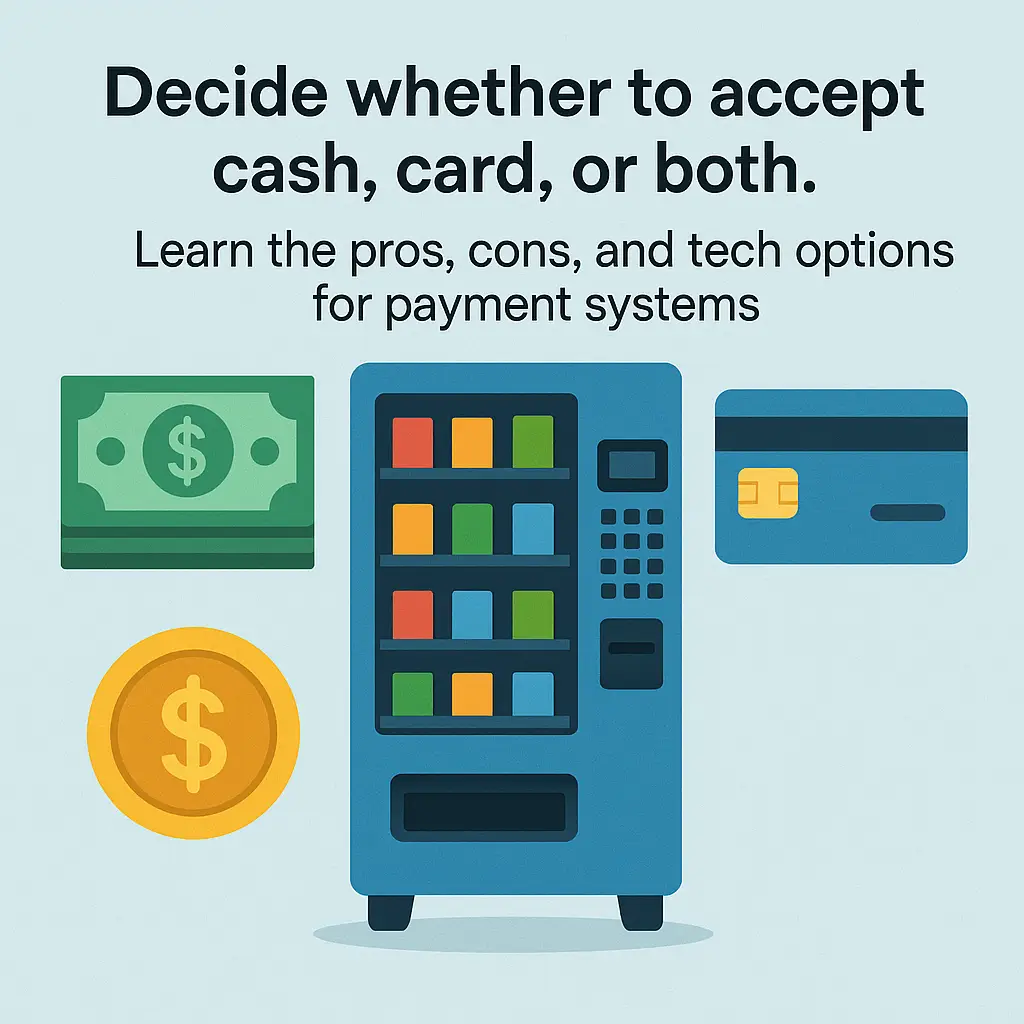Cash vs Credit Card Readers in Vending
Decide whether to accept cash, card, or both. Learn the pros, cons, and tech options for payment systems.
Back to Vending Business Startup ResourcesDecide whether to accept cash, card, or both. Learn the pros, cons, and tech options for payment systems.
Back to Vending Business Startup ResourcesStart your 30-day free trial and get instant SMS and email alerts whenever a local business needs vending service. These are real location leads to help you grow your route — you decide which ones to buy, no obligations or contracts.
![]() Card readers allow contactless payments via phone or watch
Card readers allow contactless payments via phone or watch
![]() Cashless vending reduces theft and bill jam maintenance
Cashless vending reduces theft and bill jam maintenance
![]() Dual payment options increase customer purchase flexibility
Dual payment options increase customer purchase flexibility
30 days free, then $39 / month.
No Commitment. Cancel Anytime.

Choosing between cash and credit card readers in vending machines is a crucial decision for new and experienced operators alike. Each method has pros and cons, and understanding your customer base, location type, and maintenance capabilities is key to choosing the right setup.
Cash-only machines offer simplicity and lower upfront costs. They don’t require internet connectivity and are generally easier to maintain if kept in secure locations. However, drawbacks include more frequent servicing to collect bills and coins, vulnerability to theft, and customer frustration with exact-change-only systems. Additionally, trends show fewer people carrying physical cash, especially in office or college environments.
On the other hand, credit card readers—including POS systems that accept tap, swipe, or mobile wallet payments—increase sales potential by offering convenience. They typically attract more spontaneous purchases and reduce physical vandalism or cash theft. Smart readers can also deliver real-time inventory tracking and usage analytics, helping optimize stock and route planning.
However, these benefits come with added costs. Payment processors charge transaction fees—usually between 1.5% and 3%—along with possible platform or connectivity fees. Equipment installation may also require cellular or Wi-Fi access, depending on your machine and reader type. But for many vending locations—especially offices, apartment buildings, and academic campuses—the convenience of cashless payments often justifies the investment.
To mitigate risk, some operators opt for hybrid machines that accept both cash and card. This ensures you're not alienating customers who still prefer cash but still cater to the growing contactless audience. If you're just starting out, evaluate the demographics of your target location, expected traffic volume, and whether the location budget supports a modernized machine setup.
Smart equipment opens the door to more opportunities too—including AI coolers and micro markets that require digital-only payments. Consider your long-term vending strategy before locking into any one technology.
To better understand what to invest in, you might also explore topics like paying for vending machine placement or weigh the pros and cons of free versus paid vending leads.
Vending Exchange connects vending operators with real businesses actively looking for vending services—including traditional machines, AI coolers, and office coffee. Get instant SMS and email alerts when new opportunities are available in your area. No contracts or monthly fees—just buy the leads you want. Start your free 30-day trial today and grow your vending business on your terms.
Most modern consumers prefer card or mobile payments, especially in workplaces and schools. Offering both can maximize sales.
Yes, for high-traffic or tech-savvy areas, the sales boost typically offsets the 1.5–3% fees.
Yes, many vending machines support hybrid payment setups to offer maximum flexibility to customers.
They require reliable internet access and occasional firmware/software updates, but less cash servicing.
Basic readers start around $200–$300, plus processing setup and potential monthly fees depending on the company.
Many use cellular connectivity, but weak signal areas might require boosters or Wi-Fi-enabled solutions.
Yes, cashless machines lower risk of break-ins and internal theft, making them ideal for lower-security locations.
Yes, rural or blue-collar areas may still rely on cash, so dual acceptance is often advised.
Absolutely. Most modern card readers offer cloud-based dashboards to track inventory and revenue in real time.
Not all. Verify compatibility before purchasing or upgrading your equipment to avoid installation issues.